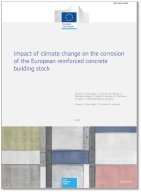Details
- Publication date
- Country
- Italy
- Authors
- DIMOVA Silvia; POLO LOPEZ Cristina Silvia; SOUSA Maria Luisa; RIANNA Guido; BASTIDAS-ARTEAGA Emilio; NOGAL Maria; GERVÁSIO Helena; MARTORANA Emilio; REDER Alfredo; ATHANASOPOULOU Adamantia
- Editors
- DIMOVA Silvia; POLO LOPEZ Cristina Silvia; SOUSA Maria Luisa
- Publisher
- Publications Office of the European Union
- Published in
- JRC Publications Repository
- Edition
- 2nd
- Publication type
- JRC report
- ISBN 978-92-68-14323
- doi: 10.2760/016004
Abstract
The published on 11 April 2024 JRC report 'Impact of climate change on the corrosion of the European reinforced concrete building stock' reveals the extent of climate change effects on the corrosion of the reinforced concrete building stock in Europe due to carbonation of the concrete cover. Recent buildings constructed to current European standards are less susceptible to corrosion than the old ones built in 20th century. The projected cost for the EU Member States to repair the carbonation-triggered corrosion by the year 2100 is expected to reach approximately EUR 76 billion under the Representative Concentration Pathway 4.5 (RCP4.5) scenario based on moderate mitigation action, and EUR 883 billion under the extreme RCP8.5 scenario, where no mitigation action is undertaken. The study proves that if there would be no climate change, the depth of carbonation would be much smaller than the depth of the concrete cover and would not lead to corrosion process.
The report underscores the significant economic and structural health challenges posed by climate change induced carbonation and provides policy recommendations to speed the adaptive measures across the EU Member States.

Original publication
The study provides assessment of the penetration of climate change induced carbonation in the concrete cover of the existing buildings in the EU Member States. It estimates the time for on-set of corrosion due to depleting of the cover of the reinforcement, and evaluates the repair costs under the moderate emissions scenario RCP4.5, and under the extreme scenario RCP8.5.
The results conclusively show that if there would be no climate change, the depth of carbonation would be much smaller than the depth of the concrete cover and would not lead to corrosion process. The study proves that the carbonation triggered by the long-term climate projections up to 2100 does not pose a threat to recent concrete buildings that follow the recommendations of the modern European standards for durability of the concrete cover. However, the climate change induced carbonation is expected to trigger corrosion in the building stock, which was designed upon the standards of the 20th century.
The projected cost for the EU Member States to repair the carbonation-triggered corrosion by the year 2100 is expected to reach approximately EUR 76 billion under RCP4.5 scenario and EUR 883 billion under RCP8.5 scenario. Under the more severe emissions scenario the corrosion process of ‘old’ buildings might start around 2050, while under the moderate scenario the onset of the process is expected after 2060.
The influence of the condition of the built environment on the Member States' economy is profound. The findings of the study necessitate development of guidance and regulations to mitigate the consequences of the climate change induced carbonation.
